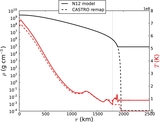The Deflagration Stage of Chandrasekhar Mass Models for Type Ia Supernovae. I. Early Evolution
Abstract
We present high-resolution, full-star simulations of the post-ignition phase of Type Ia supernovae using the compressible hydrodynamics code Castro. Initial conditions, including the turbulent velocity field and ignition site, are imported directly from a simulation of the last few hours of presupernova convection using a low Mach number code, Maestro. Adaptive mesh refinement allows the initial burning front to be modeled with an effective resolution of 36,8643 zones (136 m zone-1). The initial rise and expansion of the deflagration front are tracked until burning reaches the star's edge and the role of the background turbulence on the flame is investigated. The effect of artificially moving the ignition location closer to the star's center is explored. The degree to which turbulence affects the burning front decreases with increasing ignition radius since the buoyancy force is stronger at larger radii. Even central ignition—in the presence of a background convective flow field—is rapidly carried off-center as the flame is carried by the flow field. We compare our results to analytic models for burning thermals, and find that they reproduce the general trends of the bubble's size and mass, but underpredict the amount of buoyant acceleration due to simplifying assumptions of the bubble's properties. Overall, we find that the amount of mass that burns prior to flame break out is small, consistent with a "gravitationally confined detonation" occurring at a later epoch, but additional burning will occur following breakout that may modify this conclusion.
- Publication:
-
The Astrophysical Journal
- Pub Date:
- February 2014
- DOI:
- 10.1088/0004-637X/782/1/11
- arXiv:
- arXiv:1309.4042
- Bibcode:
- 2014ApJ...782...11M
- Keywords:
-
- convection;
- hydrodynamics;
- methods: numerical;
- nuclear reactions;
- nucleosynthesis;
- abundances;
- supernovae: general;
- white dwarfs;
- Astrophysics - Solar and Stellar Astrophysics
- E-Print:
- 60 pages, 21 figures, accepted to ApJ
